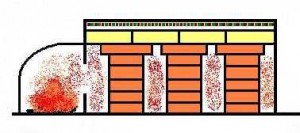How did Roman Underfloor Heating Work
Hypocausts – an ancient Roman system of central heating – worked by raising the floor of a room off the ground on a series of stone pillars (pilae stacks), thereby allowing hot air and smoke to be filtered under it through holes leading to an exterior fire and, consequently, supply a steady stream of heating to the house through convection.
Smoke was prevented from entering the room by architects leaving holes in the surrounding walls, allowing it to filter through these enclosed spaces and out of flues onto the roof.
Hypocausts were labour-intensive to operate as a large exterior fire or furnace had to be supplied with wood to maintain heat levels. Because of this, hypocausts were often only a feature of public bath houses and large private villas owned by wealthy families.
 Their invention is often credited to Sergius Orata, a famed merchant and engineer of the Roman Republic, who specialised in designing and building Roman baths.
Their invention is often credited to Sergius Orata, a famed merchant and engineer of the Roman Republic, who specialised in designing and building Roman baths.
With fundamentals very much akin to the central and underfloor heating systems we have today, the hypocaust is often credited as one of the Roman’s most forward-thinking and useful inventions, helping to increase the living conditions and hygiene of citizens considerably.
